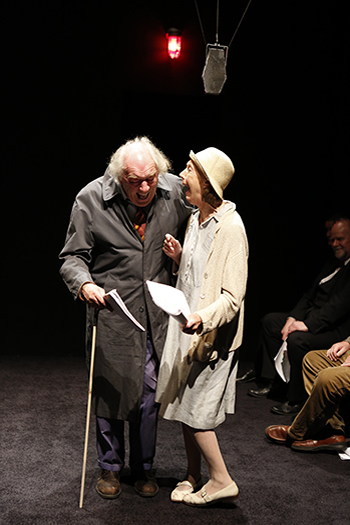
Out of the Dark
By Jonathan Kalb
All That Fall
By Samuel Beckett
59E59 Theaters
Box Office: (212) 279-4200
Samuel Beckett famously refused every request to adapt any of his six radio plays for the stage, believing that the power of the work depended on “the whole thing’s coming out of the dark.” “To ‘act’ it is to kill it,” he wrote to his American publisher, and since his death in 1989 his estate has generally held that line, granting permission only for actual radio productions or staged readings whose producers agree to limit the action to actors speaking the lines and walking to and from chairs. Directors are a notoriously persistent bunch, however, and they have never ceased testing the restrictions—particularly with All That Fall (1957), the first and most elaborate radio play whose hilariously conceived provincial Irish world is especially tempting to visualize. New York has seen no less than three stagings of All That Fall in recent years.
In 2006, a version John Sowle directed with Kaliyuga Arts played at the Cherry Lane Theater and cleverly exploited what might be called a loophole in the estate’s rules: it made live performance of the play’s many self-consciously artificial sound-effects into an amusing spectacle in its own right. The stage became a veritable effects playground, with a wind-machine, gravel-trays, bells, coconuts, a stationary bike and many other devices antically manipulated by actors, who wore 1950s clothing and dashed to and from old-fashioned mics. The performances were generally strong—particularly Helen Calthorpe in the lead role of Maddy Rooney—but in the end all the demonstrative emoting did upstage the experience of Beckett’s strange imagined world.
In 2012, Gavin Quinn’s version with Pan Pan Theatre Company came to BAM’s Fisher Theater, and presented no live actors. The whole play was recorded and the audience listened to it seated on white rocking chairs in a small dark space where a grid of lights on one wall and single bulbs hanging from the ceiling occasionally dimmed and brightened. It was the dullest and most pretentious Beckett I have seen, with many of the sound-effects blurred and complicated by electronic overstylization (the foot-dragging, for instance, resembled a wheezing death-rattle). Aine Ni Mhuiri’s performance as Maddy was so monotonously tremulous and feeble that half the audience was asleep by the end.
Now Trevor Nunn’s production has arrived from London, and it is as wonderfully satisfying as these others were problematic. With admirable restraint and sensitivity, Nunn has avoided the pitfalls of too much visualization while also demonstrating how much can be gained by visually presenting some masterful acting. His singular approach has been to half-stage the play, meaning that the nine actors, in humble Irish period costumes, mostly sit expressionless on chairs to either side of a small carpeted stage with a grid of old coffin-shaped mics overhead. The only other set element is a cutout automobile door beside a chair and stool.
The frame of Beckett’s play is a deflated epic journey in which fat, rheumatic, irritable old Maddy walks to a train station to fetch her blind husband Dan and then escorts him home. The cutout car door is used to enact the episode when debonaire Mr. Slocum offers Maddy a lift, one of dozens of diversions, distractions and delays that give the action color, character and vibrancy. The Slocum sequence is the only one acted so literally, however, as all other engagements with animals, carts, music, trains, etc., are done with recorded effects. All the dialogue is “read” by the actors, who rise with scripts in hand, speak with intense emotional investment and understanding but minimal motion and expression, and then sit down again. This technique leaves space and time to think and imagine while also providing powerful intermittent prods to the imagination in the superb performances.
The heart of the production is Eileen Atkins’s performance as Maddy. Atkins’s expressions are not minimal (nor are Michael Gambon’s as Dan), and she has grasped the nuances of her character’s peculiar humor, testiness, fear, bombast and self-consciousness as well as any other actress I have heard, including Mary O’Farrell in the original BBC radio version. Atkins is the only actor standing almost the entire time, and her wit, intelligence and clear emotional arc form a vital thread binding the 75-minute show together. With so much only partially enacted, the production could easiliy have grown filmsy, yet the two lead actors give it an anomalous gravity. Gambon’s booming, domineering voice provides welcome aural ballast when it arrives in the play’s second half, and his and Atkins’s rapport as a grumpy old couple is hilarious and heartbreaking at the same time. Their outburst of laughter at the prospect of this week’s sermon subject—“The Lord upholdeth all that fall and raiseth up all those that be bowed down”—is so bizarrely explosive, sustained and pumped full of ironic wisdom that the audience cannot help but laugh along.
I do have one quibble: the mystery in the plot of All That Fall that Beckett left unresolved has been answered by Nunn and Gambon. This is the question of whether Dan Rooney somehow caused the death of the little boy that delayed his train. When asked about this incident, Gambon's Dan responds with overcompensatory yelling that amounts to a tacit admission of guilt, and places an unnecessarily neat bow on a package better left untidy. What is remarkable about the production is how much else in it is brilliantly unkempt.
